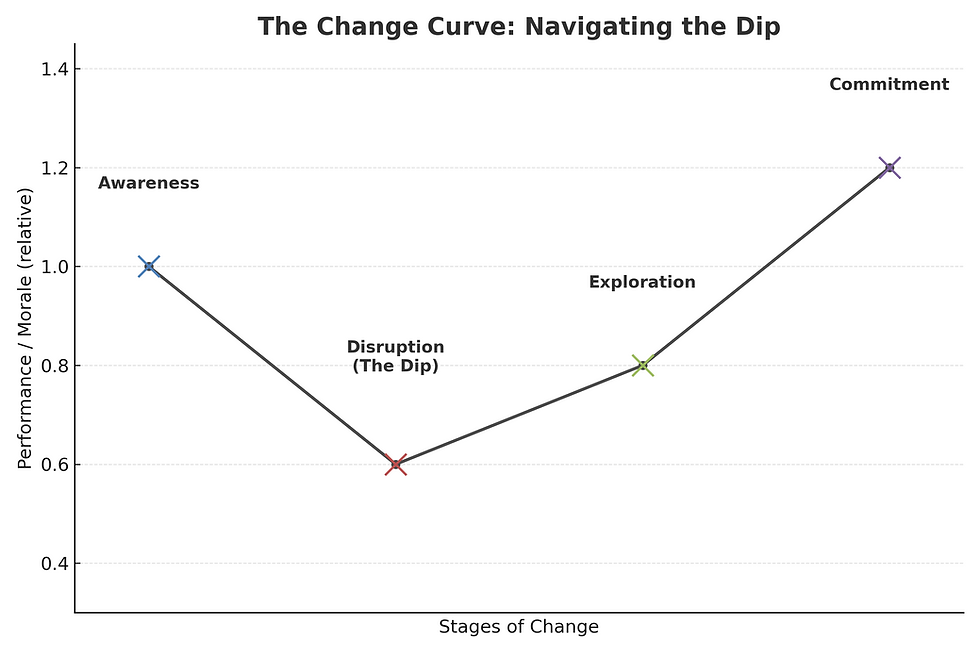Leading Change in Nonprofits: Navigating the Dip and Coming Out Stronger
- Amber Parker
- Aug 13
- 4 min read
Change is inevitable in every organization, but in nonprofits, it often comes with higher stakes. You’re not just adjusting workflows or adopting new technology; you’re making decisions that can impact your mission, your staff, your community, and the people you serve.
Change leadership is the intentional practice of guiding an organization through a transformation (big or small) while maintaining trust, momentum, and alignment with your mission. It’s not just about managing logistics. It’s about leading people through uncertainty toward a shared vision of a better future.
Why Change Happens in Nonprofits
Nonprofits face change for many reasons. You might be:
A new leader stepping into a role where change is needed to improve efficiency or culture.
An entrenched leader is faced with outside pressures such as economic shifts, new regulations, or sector-wide trends.
A growing organization that must “level up” in systems, staffing, and governance to sustain success.
Streamlining or shedding programs that no longer serve the mission or are unsustainable.
Merging with another organization to combine strengths, reduce duplication, and increase impact.
In each case, success depends less on the nature of the change and more on how you lead people through it.
Understanding the Change Curve: Navigating the Dip
Most change models recognize what’s often called the dip, which is a period where performance, morale, or both decline before they improve. Think of it as the messy middle of change.
The curve typically follows these stages:
Awareness: People first learn about the change. Reactions range from curiosity to anxiety.
Disruption (The Dip): As old systems, habits, or roles shift, productivity may drop. Staff may feel frustration, loss, or resistance.
Exploration: People begin to see how the change might work, test new approaches, and gain confidence.
Commitment: The organization adapts and moves forward, often stronger and more resilient than before.
The key to navigating the dip is not to avoid it (you can’t) but to lead through it with empathy, clear communication, and consistent support.

The Elements of Effective Change Leadership
Leading change well requires a blend of strategy, empathy, and persistence.
Here are the core elements to focus on:
Vision: Clearly articulate the “why” behind the change and the outcomes you’re aiming for.
Transparency: Share what you know, admit what you don’t, and update people as information evolves.
Inclusion: Give staff, board, and stakeholders a voice in the process where possible. Participation fosters buy-in.
Consistency: Keep the message steady across all communication channels.
This, to me, is the most important element to change leadership. I think of it like turning an ocean liner. Turning a ship of that size is not a quick process. It’s slow, requiring a steady, constant pressure from the engines to make that slow turn. A leader is the engine of change. As a leader, you have to create a consistent, constant force to turn the organization. You accomplish that through consistent communication, planning, and feedback that help you gauge the movement and know when you are finally on course. That’s when you can open up the throttle and zoom ahead.
Adaptability: Listen to feedback and be willing to adjust plans without losing sight of the goal.
Communication: Your Most Important Tool
When it comes to change, silence breeds anxiety. To build trust and maintain momentum:
Start early. Communicate before rumors fill the gaps.
Be honest. People respect leaders who acknowledge challenges rather than glossing over them.
Repeat the message. People need to hear the same information multiple times to fully absorb it.
Make it a two-way street. Invite questions, feedback, and ideas, and respond to them.
Tailor the message. Staff, board members, volunteers, funders, and partners may need the same information framed in different ways.
When people understand the purpose, the plan, and their role in it, they’re far more likely to support the journey.
Steps to Lead Change Successfully
While every change process is unique, these steps provide a useful roadmap:
Assess the Need – Identify why the change is necessary, supported by data and mission alignment.
Build the Case – Develop a clear, compelling vision and share it widely.
Engage Key Stakeholders – Involve your board, leadership team, and trusted partners early.
Create a Plan – Outline timelines, responsibilities, milestones, and communication strategies.
Communicate & Listen – Keep conversations going at every stage.
Support Through the Dip – Provide resources, training, and encouragement to help people adapt.
Celebrate Wins – Recognize progress, even in small steps.
Embed the Change – Ensure new processes, behaviors, and systems become part of the culture.
The Mindset Shift
Change leadership is as much about mindset as it is about management. It requires believing that your organization is capable of evolving, and that the discomfort of the dip is worth the stronger, more effective organization on the other side.
When you lead change well, you’re not just guiding people through uncertainty. You’re building resilience, adaptability, and trust, qualities your organization will rely on again and again.
Change will happen in your nonprofit, whether you initiate it or it’s thrust upon you. The difference between disruption and transformation lies in how you lead it.

Comments